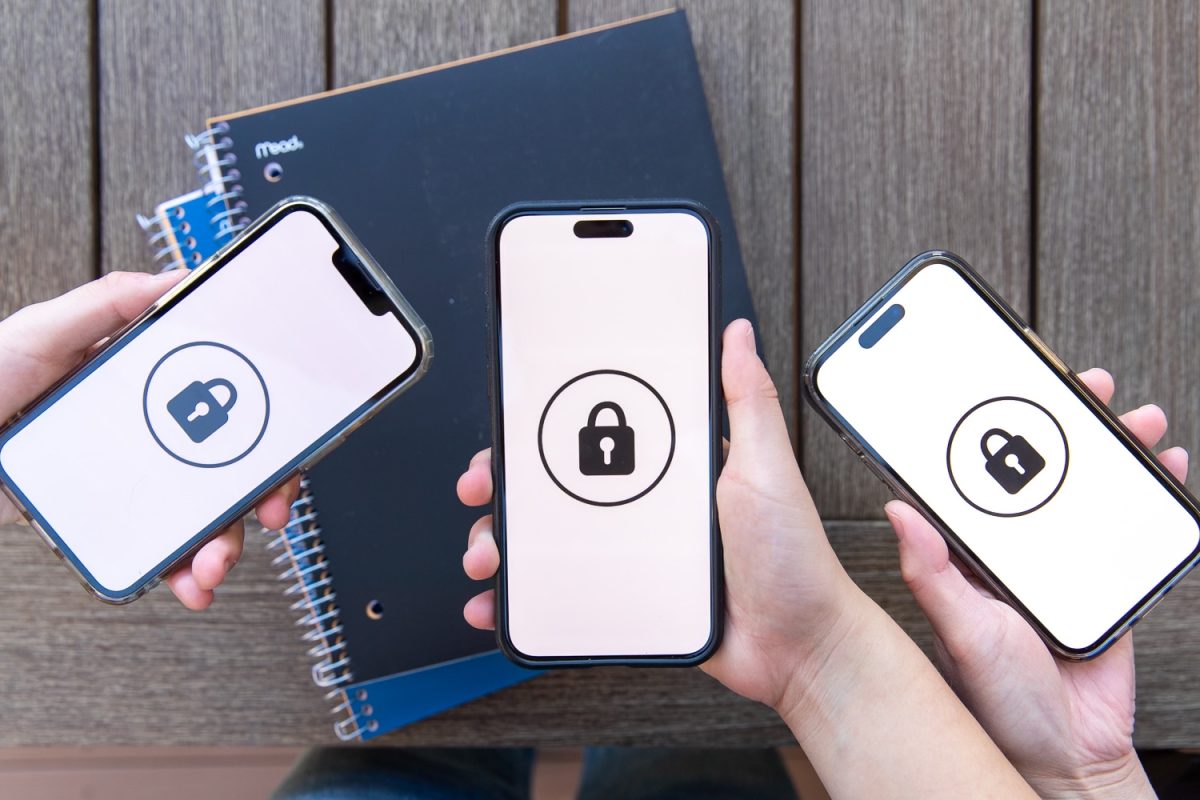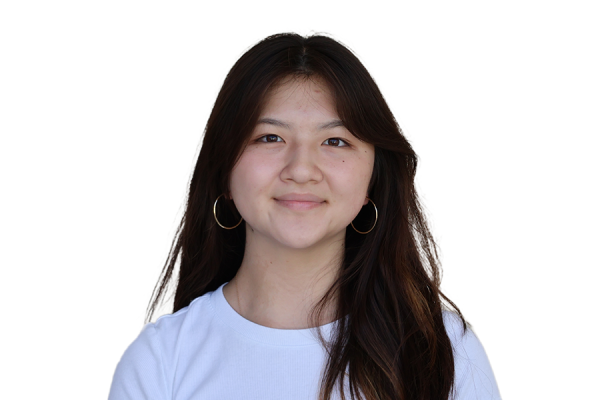Ninety-seven percent of students use their phones during school hours, with a median use time of 43 minutes per day, according to a study by Common Sense Media.
Teachers and school administrators have had enough.
Rising concerns about devices distracting from social interaction and learning have made cell phone use at school a national issue. As students have made their return to campus after their summer vacation, many classrooms have implemented notable changes.
While policies differ from school to school, numerous high schools and middle schools across California are employing various phone restrictions. Both private and public high schools are adopting different approaches, but all aim to limit cell phone usage in learning environments.
These measures range in severity from simply not allowing phones out in class to using cell phone pockets or even magnetic sealing pouches for each student to carry.
“Teachers were tired of competing with phones in the classroom,” said Trisha Lancaster, the executive director of SOAR Charter Academy, a TK-8th grade school in San Bernardino that has implemented a preventive personal device policy for the past year. “After the pandemic, students faced learning loss and social and emotional concerns. Burying their heads in their phones instead of interacting and engaging with others was not helping.”
According to Lancaster, California Governor Gavin Newsom enabled schools in 2019 to enforce measures addressing cell phone use. Now, there is a major push across the state to tackle the problem.
Carlmont High School, part of the Sequoia Union High School District, is among the schools around San Mateo adjusting its policy this year due to teacher concerns about distractions caused by cell phones during class time.
“The policy change came largely from requests by teachers through our Site Council and our Department Chair Council,” said Gay Buckland-Murray, the principal of Carlmont High School. “We talked about the challenge of cell phone use in classes and how to change the school culture around cell phones in the learning space. Before this year, the directive had been that cell phones should be off and away during class time, but that was enforced with a huge degree of variety across the school.”
Carlmont administration determined that by creating a clear guideline requiring ninth graders to put their cell phones in designated pockets at the beginning of class, the practice would become the school culture over time. As a result, first and second-year students are seeing stricter enforcement of this policy, while juniors and seniors are seeing varied enforcement depending on a teacher-to-teacher basis.
This trend isn’t unique to Carlmont. Other local public high schools, such as Hillsdale High School, are also implementing new personal device policies, especially for incoming students.
Hillsdale High School, like Carlmont, requires students to place their phones in phone pockets or lock boxes at the beginning of class. However, this policy has not seriously affected upperclassmen.
“I probably only use a phone pouch in two out of my six classes. I think for freshmen, it varies from teacher to teacher, but more of their classes have it,” said Naia Hsieh, a senior at Hillsdale.
This is the first year Hillsdale has implemented such a policy. Their approach appears less strict than Carlmont’s, likely due to student reaction, according to Hsieh.
“Hillsdale has had a lot of pushback against cell phone regulation because people are really attached to their phones. People talk about it, and there’s lots of complaining whenever teachers introduce the phone pockets,” Hsieh said.
Device policies at smaller public and private schools are a different story. Many of these schools are implementing much stricter measures, partially due to how much easier it is to enforce such policies with a small student population.
At Junipero Serra High School, a private high school for boys in San Mateo with around 200 to 230 students per grade level, the device policy has recently become far stricter in response to increased unpermitted phone usage.
Initially, Serra’s policy prohibited any phone use, with violations resulting in phone confiscation and an hour of detention. Recently, the school has increased the detention time to three hours.
“As of now, our school’s phone policy states that we are allowed to use our phone as long as it is lunch and we are in one of the designated spots like the cafeteria, field, or bathroom—not the hallway,” said Jonah Buan, a student at Serra.
Buan enjoys the new rules for phone use during lunch but believes the three-hour detention for the minor infraction of pulling out a phone is unjust and unfair.
“While phones are interfering with education in some ways, they are still integral to not only the social life but the daily life of an average teenager. For our generation, who grew up with such systems, devices, and software, trying to pry that out of our hands is virtually impossible,” Buan said.
One of the most controversial approaches to cell phone usage in educational spaces is Yondr pouches. These electromagnetic phone pouches, used in thousands of schools worldwide, are given to each student and remain locked for the entire school day. Design Tech High School, a public charter school with 500 students, has used phone pouches for the past two years.
The school has adjusted its policy based on community feedback, but many students remain unsatisfied. In 2022, when Yondr pouches were first introduced along with two other systems that restricted students’ online activities and movement around campus, the school experienced a student-led protest, which resulted in the suspension of multiple students afterward.
“Since its implementation, there have been some very slight changes in an attempt from the school admins to ‘listen’ to their community, such as giving each teacher a magnet to prevent a rush of students trying to unlock their phones at the end of school or exceptions to the rule on special occasions, such as Halloween,” said Nathan Tam, a junior at Design Tech.
Ever since the pouches were implemented, students have discovered various ways to bypass their locks, such as bringing their own magnets to school, breaking the pin that holds the pouches close, or striking the pouches with enough force to break them open.
According to Tam, the policy’s effectiveness is debatable as disruptions from phone use in class have been replaced by teachers repeatedly asking students to put their phones back in their pouches.
Tam noted that while the school’s system has made it better and easier to socialize with others, he still disagrees with it.
“Regardless of these benefits, it just doesn’t feel like a sustainable or long-term solution to these issues. Forcing people together really isn’t worth the cost and the negative view most of the school has about the administration,” Tam said.
Tam’s concern about cell phone restriction not being a long-term solution is shared by teachers such as James Bohac, a physics instructor at Carlmont. The price of prioritizing a distraction-free environment could result in students’ inability to self-regulate.
“By mandating cell phone use in pockets, we’re limiting your ability to learn self-discipline. If you don’t learn it now, when will you? To learn how to live independently and effectively, you need to develop self-discipline, including managing your own cell phone use. By us monitoring your phones, we’re taking that responsibility out of your hands,” Bohac said.
Student responses vary, as is natural, given the shift from summer screen time to limited screen access, and different schools will need to adjust accordingly. Nonetheless, cell phone policy restrictions appear to be having a positive effect.
“So far, the teachers, staff, and parents have been very supportive of our intentional enforcement of the policy. It is too early to tell how effective we have been, but from informal conversations with teachers, they indicate there has been increased student engagement in the classroom,” said Grant Steunenberg, the administrative vice principal at Carlmont.
According to Buckland-Murray, parent responses have been overwhelmingly positive. When the Carlmont administration announced the rule at 9th grade parent night, they were met with warm applause and approval and have since received appreciation from various parents.
Nothing is perfect yet; there is always room for growth. As the policy is in its early days, Carlmont will continue to explore what works and what doesn’t, following a cycle of inquiry: starting with the policy, examining its effectiveness, making changes, and then repeating the process.
“You can only begin working on a problem once you begin to address it. I believe the steps our staff have taken will be a good start to establishing those boundaries and will begin to help students develop and form good habits as they transition from adolescence to adulthood,” Steunenberg said.
In an increasingly modern and digital world, society will need to learn how to balance technology use, especially in educational settings. Like Stenuenberg, the principal voiced her optimism about the new policy.
“I’ve been very proud and appreciative of our school students and staff for being willing to try something new. I’m also hopeful that students are starting to realize they don’t need their phones. What I love is when, at the end of the day, a student calls to say they left their phone in a classroom. It shows that the phone isn’t so important to them that they can’t leave it behind, which I think is a good sign,” Buckland-Murray said.













